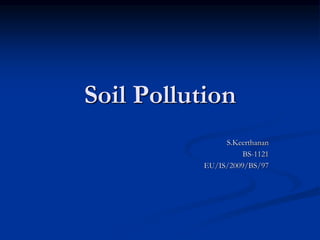
soilpollutionbs1121-160223095736.pdf
- 2. What is soil? Soil is defined as the top layer of the earth’s crust. It contains inorganic matter, organic matter, water, air and many living organisms. Soil provides support and nutrients for plant growth. The healthy soil has a valuable asset. It has been receiving more and more toxic substance.
- 3. What is soil pollution? It is defined as the build-up in soils of persistent toxic compounds, chemicals, salts, radioactive materials, or disease causing agents, It occurs due to rapid growth in industrial development, intensive agriculture and other anthropogenic activities. Soil pollution may change physical, chemical and biological nature of soil and make it unfit for plant growth, animals and human use. These pollutants decrease soil quality, disturb the soil's natural balance.
- 4. The major sources of soil pollution are: Pollutants like acids washed off from the atmosphere (acid rain). Pesticides and herbicides sprayed in fields. Excessive use of artificial fertilizers. Solid wastes like garbage, trash, ash, building material, plastic, bottles and cans. Storage and disposal radioactive waste from the power plant.
- 5. Cont… Seepage from a landfill. Discharge of industrial waste into the soil. Percolation of contaminated water into the soil. Rupture of underground storage tanks. Deforestation and soil erosion.
- 6. The most common chemicals involved in causing soil pollution are: ■ Petroleum hydrocarbons Heavy metals Pesticides Solvents
- 7. Types of Soil Pollution Agricultural Soil Pollution. Industrial Soil Pollution. Urbanization Soil Pollution.
- 8. Agricultural Soil Pollution. Plants on which we depend for food. Under attack from insects, fungi, bacteria, viruses, rodents and other animals. To kill unwanted populations living in or on their crops, farmers use pesticides and herbicides. Pesticides and herbicides are applied to agricultural land to control pests that disrupt crop production. Soil contamination can occur when pesticides persist and accumulate in soils.
- 9. Agricultural effects Reduced soil fertility. Reduced nitrogen fixation. Larger loss of soil and nutrients. Deposition of silt in tanks and reservoirs. Reduced crop yield.
- 10. Excess use of Fertilizer Use of Pesticide
- 11. Industrial Soil Pollution Large quantity of solid wastes like unused and rejected chemicals (like sludge, press mud, saw dust, bottles, plastic materials etc.), unwanted industrial wastes generated during manufacturing processes are dumped over on the surface of soil. Normally, These materials have been dumped around the factory site or around the entire city.
- 12. Industrial effects: ■ Dangerous chemicals entering underground water. Ecological imbalance. Release of pollutant gases. Increased salinity. Reduced vegetation.
- 14. Urbanization Soil Pollution Urban activities generate large quantities of city wastes including several non-biodegradable materials (such as plastic bags, plastic bottles, plastic wastes, glass bottles, glass pieces, stone / cement pieces). If it uncollected , they cause soil pollution. The emission of toxic and foul gases from landfills pollutes the environment and causes serious effects on health of some people. The unpleasant smell causes inconvenience to other people.
- 15. Urbanization effects: ■ Pollution of drinking water sources ■ Public health problems ■Clogging of drains ■Waste management problems ■ Inundation of areas ■Foul smell and release of gases ■Spread out diseases by pathogenic organisms.
- 17. The major effect of soil pollution Salinization: is increase the soil content of soil. Salinization occurs due to Acid rain, Agricultural operation, and industrial activities. Due to salinization the soil becomes unsuitable for plant growth and human use. Ground water in saline soil have more salts than normal soil and make the water unsuitable for plant growth, for animals and for human use.
- 18. Methods to control Soil Pollution Reducing chemical fertilizer and pesticide use. Recycling Recycling paper, plastics and other materials reduces the volume of refuse in landfills. Reusing of materials such as plastic bottles, glass, etc Re-forestation, Planting trees or re-forestation helps prevent soil erosion and pollution.
- 19. Methods to control Soil Pollution Use traditional method to reduce growing of pests and weeds. Designated pits should be used for the dumping of soil wastes. These wastes should be treated chemically and biologically to make them less toxic and hazardous. Minimizing emissions from motor vehicles and industries (to control acid rain).
- 21. Responsibility
- 22. Thank You For Your Attention